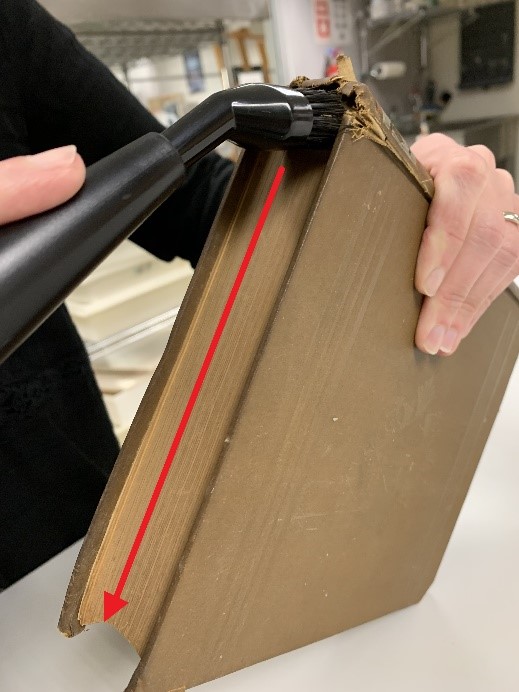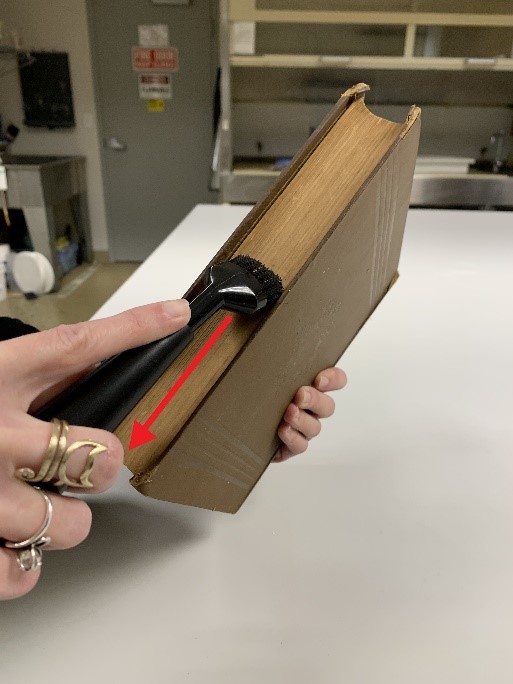NEDCC Staff
Northeast Document Conservation Center
INTRODUCTION
Cleaning the books in a circulating collection extends their useful life. Regular cleaning reduces surface dirt and dust, which in turn can help control mold and insect infestations. The frequency of cleaning will depend on how rapidly dust and dirt accumulate where collections are stored. It is important to note that despite the benefits of cleaning, cleaning actions can damage fragile bindings, brittle pages, and leather that is powdery or flaking.
Cleaning books in special collections requires more expertise than described in this leaflet, and a conservator should be consulted before beginning any large cleaning project.
Understanding cleaning procedures for circulating collections and identifying potential risks will improve your judgment when deciding when and to what extent to clean collection materials.
If books and shelves are to be cleaned in response to a mold outbreak, consult the NEDCC Preservation Leaflet 3.8 Emergency Salvage of Moldy Books and Paper, https://www.nedcc.org/free-resources/preservation-leaflets/3.-emergency-management/3.8-emergency-salvage-of-moldy-books-and-paper.
If books are to be cleaned as part of a COVID-19 disinfection protocol, consult the NEDCC Preservation Leaflet 3.5 Disinfecting Books and Other Collections, https://www.nedcc.org/free-resources/preservation-leaflets/3.-emergency-management/3.5-disinfecting-books.
Preparing for cleaning
Organizing a cleaning project will depend upon several factors:
- the physical condition of the books;
- the amount and type of soil to be removed (a light layer vs. a heavy accumulation);
- the significance of the books (is their value based on the information they contain, or do they have historic, artistic, or associational value as well?); and
- the scope of the cleaning to be undertaken (is cleaning ongoing to maintain every book in the library, or is it a limited project designed to clean only books in a particular area or collection?)
Once these questions have been answered, procedures can be developed for training purposes. This leaflet covers basic cleaning procedures for general collections. Details on specific cleaning topics can be found in the section, “Resources.”
Preventative measures
To reduce the amount of dust and dirt that accumulates on books and shelving, regular cleaning of floors is essential. Because sweeping stirs up dust rather than removing it, vacuuming and dust mops are preferable. The preferred method for floors is vacuuming, followed by a dust mop or wet mopping. Use a well-squeezed mop to avoid splashing books on the lower shelves. To prevent excess dust, it also helps to change filters as recommended on HVAC systems and to keep windows closed.
Cleaning
Books
Bindings and text block edges can be cleaned with magnetic wiping cloths or by vacuum. Each method has advantages and disadvantages that should be considered before cleaning begins.
For lightly soiled books, magnetic cloths work well—especially if the text block is trimmed smoothly and the bindings are in stable condition (with no flaking of cloth or leather). Magnetic cloths do not contain chemicals or other substances that could be left behind on books and are, in general, not too “toothy” (rough). For these reasons, they are recommended over standard cleaning cloths. Standard cleaning cloths and micro-fiber cloths may contain chemicals that attract or repel dust; these chemicals can leave a residue on books and are therefore are not recommended.
Magnetic cloths should not be used on books with deckled or untrimmed edges, where the soiling is heavy, or on books that have been coated in soot. Under these conditions, the wiping motion used with these cloths can abrade items as well as rub dirt into paper fibers.
If books are covered with a heavy layer of dust or the number of books to clean is large, using a HEPA vacuum with a soft brush attachment (or separate brush) is recommended. If possible choose a vacuum with variable speed controls that allow you to decrease the suction. Micro tool sets, which are inexpensive and attach to most vacuum cleaner hoses, can help clean areas of a book that may be too difficult to access with standard vacuum attachments. To clean dirty books, regardless of the cleaning medium, follow these simple steps:
- Hold the book firmly closed to prevent dirt from slipping between the leaves.
- Clean the top (head) of the book first, as it is usually the dirtiest.
- Gently wipe or brush away from the spine to avoid pushing dirt down into the spine of the binding and to avoid damaging the endcap.
-
Proceed to clean the rest of the book, wiping or vacuuming outward from the spine or center to the edges.
 |
 |
| Cleaning the head of the book | Cleaning the fore edge of the book |
- Do not rub the magnetic cloth or vacuum attachment back and forth along the surface of the book when cleaning as this could damage the text block and covering material.
- Change magnetic cloths when they get dirty.
- Cloths used to clean shelves should not be used to clean books.
 |
 |
||
|
|
|||
A short video demonstrating how to vacuum a book can be found here.
Two-person teams, using book carts and a vacuum, are best able to efficiently and safely clean a large volume of books. The teams should work one shelf at a time and from top to bottom. Books are removed in shelf order, placed on the cart, and individually vacuumed. While the books are being vacuumed, the shelf is cleaned (as described below). Once the books and shelves are clean, books are returned to the clean shelf in order.
Shelves
Metal shelves are best cleaned with a magnetic wiping cloth, which attracts and holds dust with an electrostatic charge. Dust cloths that are chemically treated to hold dust can be used to clean shelves but are not appropriate for cleaning books. Feather-type dusters, even magnetic feather-dusters, should not be used. These dusters only redistribute rather than remove the dust. As a result, more frequent cleanings are necessary.
Wooden shelves—or metal shelves with heavy coatings of dust—should be cleaned with a vacuum or be washed with a mild detergent. To prevent mold growth, they should be allowed to dry completely before books are returned the shelves. Spray cleaners may be used in place of water, but take care to shield surrounding items and shelves during spraying. Many of these cleaners are potentially very damaging to books due to their oils, detergents, or pH and can leave residues behind even after drying. To avoid leaving residues on shelves, wipe the shelves with a cloth and water immediately after using a chemical cleaner.
CONCLUSION
Because dust and dirt create conditions hazardous to collections and because improper cleaning is potentially damaging, informed, careful cleaning is an action that will contribute to prolonging the useful life of a collection.
By properly eliminating the dust and dirt that attracts insects and contributes to an environment that supports mold growth, staff members are contributing greatly to the preservation of their collections.
Instruction in careful handling techniques, clearly written procedures, and proper equipment are all essential to ensure quality and efficiency during cleaning projects. While handling fragile materials in a collection—even in order to clean them—will always be a cause for concern, proper cleaning techniques are always preferable to static storage.
Resources
Bendix, Caroline, and Alison Walker. Cleaning. London: The British Library Preservation Advisory Centre, 2011. https://www.bl.uk/britishlibrary/~/media/bl/global/conservation/pdf-guides/cleaning-preservation-guide.pdf
National Park Service. “Choosing a Vacuum Cleaner” Conserve O Gram 1/6 (June 2003). Accessed April 1, 2021. https://www.nps.gov/museum/publications/conserveogram/01-06.pdf
NEDCC Preservation Leaflet 3.5 Disinfecting Books and Other Collections. 2020. https://www.nedcc.org/free-resources/preservation-leaflets/3.-emergency-management/3.5-disinfecting-books.
NEDCC. Preservation Leaflet 3.8 Emergency Salvage of Moldy Books and Paper. 2021. https://www.nedcc.org/free-resources/preservation-leaflets/3.-emergency-management/3.8-emergency-salvage-of-moldy-books-and-paper.
NEDCC. “Vacuuming Moldy Books & Paper.” Video. https://youtu.be/ydmdJy-rxTg.
Ritzenthaler, Mary Lynn. Preserving Archives & Manuscripts, 141-44. Chicago: Society of American Archivists, 2010.
University of Washington Libraries. “Stacks Cleaning Procedures.” University of Washington Libraries. Accessed December 6, 2012. https://lib.uw.edu/preservation/preservation-services/preventive-preservation/clean/
Zachary, Shannon. “Managing a Stacks Cleaning Project” Archival Products New, Volume 5, No. 1. (1997). Accessed February 11, 2021. https://archival.com/newsletters/apnewsvol5no1.pdf
Attribution-NonCommercial-NoDerivs
CC BY-NC-ND
